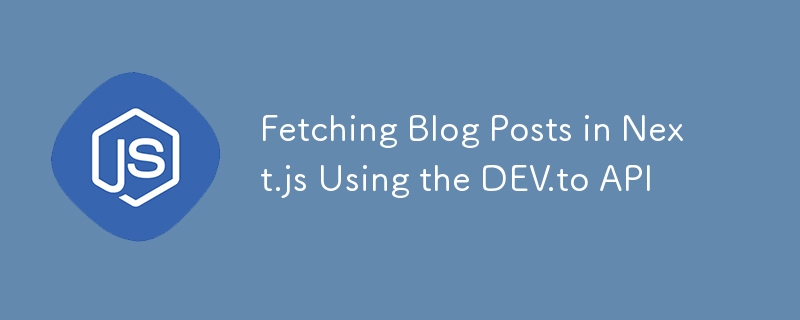

If you're looking to showcase your DEV.to blog posts on your Next.js website, you're in luck! DEV.to provides an easy-to-use API that lets you fetch your blog posts programmatically. In this guide, I'll show you how to integrate DEV.to's API into your Next.js application and dynamically display your blog content.
Let's dive in!
First, if you haven't already, set up a new Next.js project by running:
npx create-next-app@latest my-dev-blog cd my-dev-blog
Now that we have our Next.js app ready, let's move on to fetching our blog posts.
The DEV.to API provides access to your published articles through a simple HTTP request. You can fetch articles by user by hitting the endpoint:
https://dev.to/api/articles?username=yourusername
To fetch the blog posts in your Next.js app, we'll use the SWR library. SWR is a popular data fetching library designed to make it easy to fetch, cache, and update data in your React/Next.js applications.
Install SWR:
npm install swr
Now, let's create a utility function to handle the API request:
// src/lib/fetcher.ts
export default async function fetcher(url: string) {
const response = await fetch(url);
if (!response.ok) {
throw new Error("Failed to fetch data");
}
return response.json();
}
Now that we have the fetcher utility, let's create a blog page that will display your DEV.to posts.
In pages/blog/index.tsx, fetch and display the blog posts using SWR:
import { Container, Row, Col, Card, Button, Badge } from 'react-bootstrap';
import Head from 'next/head';
import useSWR from 'swr';
import fetcher from '../../lib/fetcher';
import Link from 'next/link';
import { formatDistanceToNow, parseISO } from 'date-fns';
interface BlogPost {
id: number;
title: string;
description: string;
slug: string;
cover_image: string;
tag_list: string[];
reading_time_minutes: number;
published_timestamp: string;
positive_reactions_count: number;
}
const Blog = () => {
const { data, error } = useSWR<BlogPost[]>('https://dev.to/api/articles?username=yourusername', fetcher);
if (error) return <div>Failed to load posts</div>;
if (!data) return <div>Loading...</div>;
return (
<>
<Head>
<title>Blog | Your Name</title>
</Head>
<Container>
<Row>
<Col>
<h1>Blog</h1>
<Row className="g-4">
{data.map((post: BlogPost) => (
<Col md={4} key={post.id}>
<Card className="blog-card" data-aos="fade-up">
<Card.Body>
<Card.Title>{post.title.length > 50 ? `${post.title.substring(0, 50)}...` : post.title}</Card.Title>
<Card.Text>{post.description}</Card.Text>
<div className="mb-2">
{post.tag_list.map((tag: string) => (
<Badge pill bg="secondary" className="me-1" key={tag}>
{tag}
</Badge>
))}
</div>
<div className="text-muted">
<small><i className="fa-solid fa-clock"></i> {post.reading_time_minutes} min read</small><br/>
<small><i className="fa-solid fa-calendar-day"></i> {formatDistanceToNow(parseISO(post.published_timestamp), { addSuffix: true })}</small><br/>
<small><i className="fa-solid fa-thumbs-up"></i> {post.positive_reactions_count} Likes</small>
</div>
<Link href={`/blog/${post.slug}`} passHref>
<Button variant="outline-primary" className="mt-3">Read More</Button>
</Link>
</Card.Body>
</Card>
</Col>
))}
</Row>
</Col>
</Row>
</Container>
</>
);
};
export default Blog;
Next.js provides dynamic routes that allow you to generate individual pages for each blog post. Let's create a dynamic route to display each post.
Create a file called pages/blog/[slug].tsx:
import { useRouter } from 'next/router';
import useSWR from 'swr';
import { Container, Row, Col, Card, Button } from 'react-bootstrap';
import Head from 'next/head';
import Image from "next/image";
import fetcher from '../../lib/fetcher';
const BlogPost = () => {
const router = useRouter();
const { slug } = router.query;
const { data, error } = useSWR(slug ? `https://dev.to/api/articles/yourusername/${slug}` : null, fetcher);
if (error) return <div>Failed to load the post</div>;
if (!data) return <div>Loading...</div>;
return (
<>
<Head>
<title>{data.title} | Your Name</title>
</Head>
<Container>
<Row>
<Col>
<div className="section-title">
<h1>{data.title}</h1>
<p>{data.readable_publish_date}</p>
</div>
<section>
{data.cover_image && (
<Image
src={data.cover_image}
alt={data.title}
className="img-fluid mb-3"
width={1000}
height={420}
layout="responsive"
/>
)}
<div dangerouslySetInnerHTML={{ __html: data.body_html }} />
</section>
<Button variant="outline-dark" href="/blog">
Back to Blog
</Button>
</Col>
</Row>
</Container>
</>
);
};
export default BlogPost;
This page fetches individual posts using the slug from the URL and renders them with HTML content safely using dangerouslySetInnerHTML.
You can now start your Next.js app by running:
npm run dev
Visit the /blog route, and you should see your DEV.to blog posts displayed. Clicking on any post will take you to the individual blog post page.
Feel free to customize this setup further, add pagination, or improve styling to match your site’s design!
Let me know in the comments if you have any questions or suggestions.
The above is the detailed content of Fetching Blog Posts in Next.js Using the DEV.to API. For more information, please follow other related articles on the PHP Chinese website!




